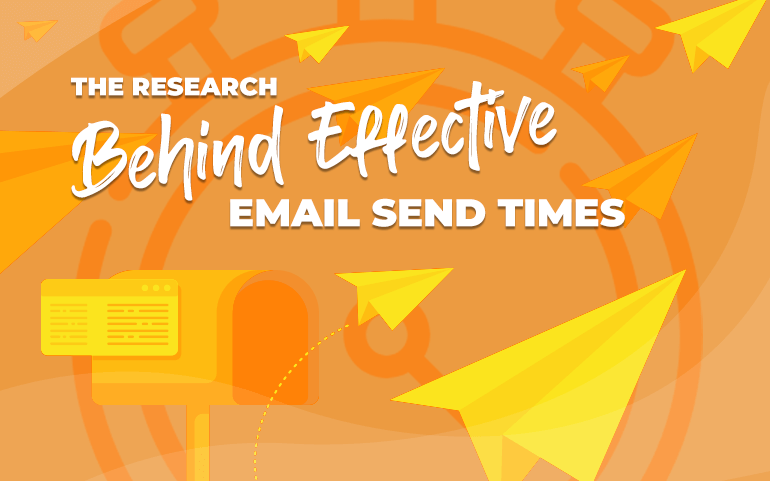If you ask 100 marketers “What’s the most effective email send time?” – you’re likely to get 100 different answers. The debate about the perfect time/day for email sends is as old as email marketing itself.
In the past, dozens of studies have tried to nail down the “golden hour” for optimizing opens and click-throughs. However, results from studies have been mixed. Still, others claim that the email send time doesn’t really matter.
While research on send times has been mixed, dismissing timing as irrelevant to your marketing strategy isn’t a wise choice. Instead, we need to take a deeper look at email timing, its effect on open and click-through rates, and the research surrounding it.
Why Are Email Send Times Important?
When we talk about email send times, we’re really discussing two similar factors: day of the week, and time of day.
What if you could get more of your target audience to open your emails simply by altering the time you send them? What if you could increase your click-through rate just by scheduling your emails a day earlier than usual? That’s why email send times are important, because the possibility of their value to your business is just too enticing to ignore.
Determining the Best Email Send Time
To understand the best time to send an email, we’ve broken down the research of a trusted industry resource. This is going beyond just numbers and statistics. We’ve included the rationale behind these results so you can make well-informed decisions for sending your emails moving forward.
Best Day to Send an Email
Since most businesses only send 1-2 emails per week, choosing the right day to send an email is important. If a message is sent on a day when the user doesn’t check their email frequently, it’s liable to be buried under a pile of other messages, potentially being opened too late, or not at all.
B2C
Studies seem to suggest that there’s actually not a big difference in open rates for specific days of the week for B2C email sends. However, for optimal performance, Saturdays tend to work best.
B2B
Studies show that B2B emails for the typical 8-5 office employee are best sent mid-week. However, this doesn’t include entrepreneurs and executives who tend to open emails more frequently than the typical employee and tend to open more emails on Saturdays. For this reason, you may want to segment your B2B audience based on role or seniority.
Best Time to Send an Email
B2C
Time of day is a little bit more complicated, simply because we’re working with more data points. Although there’s not a big difference in open rates for B2C email sends, midnight on Saturdays tends to work best.
B2B
When sending those mid-week messages, 10 AM seems to be a good time for office employees. When it comes to entrepreneurs and executives, Saturday at 10 AM typically generates the highest open and click rates.
Contextualizing These Results
While the above results are helpful and important, the truth is, they’re limited by a number of factors. First of all, this study analyzed a total of 4 billion emails. That may seem like a lot – until you realize that 289 billion emails are sent every day. In other words, this study offers a very small sample size. While these results are certainly helpful for getting an idea of what times are good and bad, it would be virtually impossible to analyze a representative sample that would absolutely prove the perfect general email send time.
It’s All About Your Audience
When it comes to finding the perfect days and times for sending your emails, the truth is, it depends on your audience – or better yet, your email list. While this might sound like a bit of a cop out, it’s true.
The average office worker probably checks their emails at different times than a college student. A retiree probably checks at different times than a young professional. The fact of the matter is, the ideal send time depends on your audience.
By keeping this in mind, your email campaign can reach, engage, and convert customers more effectively, while building a lasting relationship that enhances lifetime customer value.
Finding Your Ideal Send Time
As with many facets of ecommerce, the key to finding the perfect email send time is a combination of segmentation and… wait for it… testing. Start off by segmenting your subscribers. Just like email marketing tactics and subject lines resonate differently with different audiences, there is no one-size-fits-all approach to segmentation. However, some great starting points are geographic location and time zones. For B2C, you’ll want to pay attention to the type of products you’re marketing and how that could be perceived at different days and times. For B2B, you’ll want to take your niche into consideration. Then, determine your ideal email frequency.
The idea is to get into the mind of an average consumer to understand how they live. From there, ask yourself “When in their day would this person be checking their email?” Finally, you’re ready to test!
So, Let’s say you’re sending out an email about a new product launch. Send the email to 50% of your audience at Time X, and 50% at Time Y. By repeating this process over time, the data will show you which time works best for your audience.
Don’t Forget the Importance of Email Compliance
Finding an effective time to send your emails is important. However, it’s even more important to ensure that you stay compliant with email regulations.
If you do business in countries besides the US, it’s vital to get familiar with the laws of each locality, especially as regulations change. If you aren’t familiar with CAN-SPAM, GDPR, and other international regulations, make sure to read our Global Guide to Email Compliance, available here for free.
